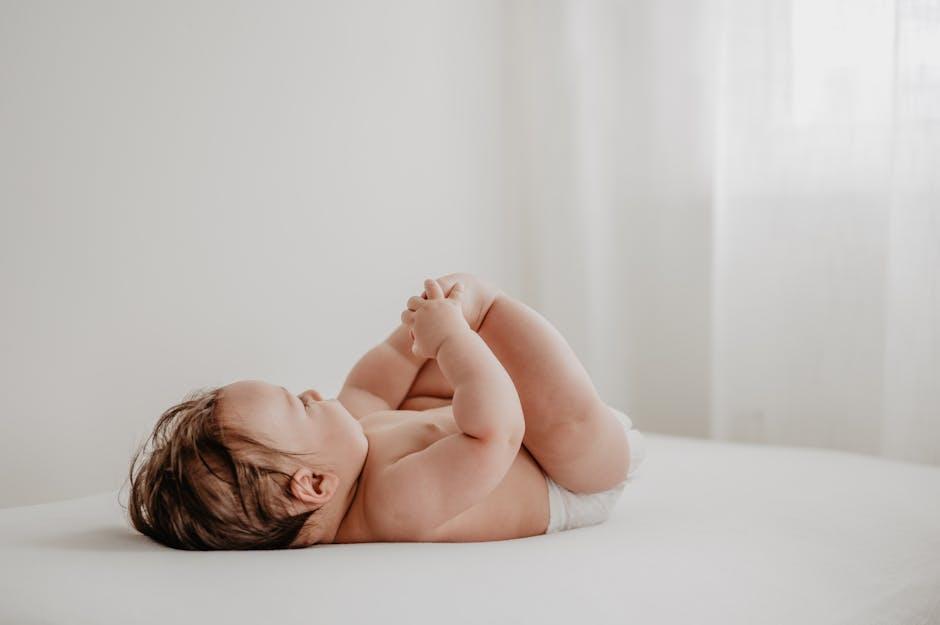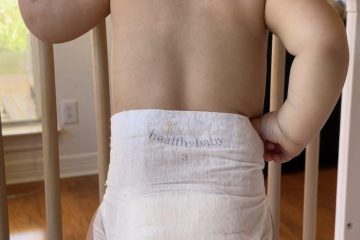Table of Contents
- Understanding the Benefits of Diaper Free Time for Infants
- Creating a Safe Environment for Diaper Free Sessions
- How to Introduce Diaper Free Time into Your Daily Routine
- Tips for Successfully Navigating Accidents During Diaper Free Time
- Alternative Products to Consider for Diaper Free Play
- Q&A
- In Retrospect


Understanding the Benefits of Diaper Free Time for Infants
Diaper-free time can be a delightful experience for both parents and infants, fostering an environment that promotes natural development. When babies are allowed some time without a diaper, it encourages freedom of movement, giving them the opportunity to explore their surroundings. This form of exploration not only sharpens their motor skills but also aids in sensory development as they interact with different textures and temperatures.
Another significant advantage of this practice is the support it offers in developing toilet training awareness. Infants learn to recognize their body’s signals when they need to relieve themselves. During diaper-free sessions, they may experience the sensations associated with elimination, promoting an early understanding of their bodily functions. This can pave the way for easier transitions to potty training as they grow older.
Furthermore, diaper-free time can enhance skin health. Prolonged exposure to moisture and waste can lead to irritations and rashes. Allowing infants to go without a diaper for certain periods encourages air circulation, reducing the likelihood of skin issues. The practice can also foster a deeper bond between parent and child, as caregivers often engage in playful interactions during these moments, strengthening their emotional connection.


Creating a Safe Environment for Diaper Free Sessions
Creating a diaper-free space requires careful planning to ensure both the baby’s comfort and the environment’s cleanliness. Start by selecting an area that is easy to clean, such as a bathroom, kitchen, or outdoor setting. Here are some items to keep in mind when preparing your space:
- Waterproof Mats: Lay down waterproof mats to protect surfaces and make clean-up simple.
- Soft Blankets: Use soft blankets to create a comfortable area for your little one to move around.
- Accessible Supplies: Keep wipes, towels, and extra clothing within reach to handle any accidents swiftly.
Establishing routines can also enhance the diaper-free experience. By observing your child’s cues, you can pick times when they are likely to relieve themselves. Consider these guidelines to create a smooth flow:
- Consistency is Key: Aim for regular sessions throughout the day, preferably after meals or naps.
- Positive Reinforcement: Celebrate successes, using praise or small rewards to encourage participation.
- Relaxing Atmosphere: Ensure the environment is calm and stress-free, assisting your little one to feel secure.
Lastly, keep an eye on safety to ensure a comfortable experience for your child. This includes monitoring the surrounding area for hazards and ensuring that your child is always supervised. Here’s a quick overview of safety considerations:
| Safety Tip | Description |
|---|---|
| Supervision | Always keep an eye on your child during diaper-free time to prevent accidents. |
| Safe Space | Clear the area of sharp objects or breakables that might pose a risk. |
| Comfortable Temperature | Ensure the room is at a comfortable temperature, avoiding overly cold or hot environments. |


How to Introduce Diaper Free Time into Your Daily Routine
Incorporating diaper-free time into your child’s daily routine can be a rewarding experience for both you and your little one. Start by designating specific periods throughout the day when your child can be free of diapers. Try to choose times when they are typically alert and happy. This could be after a diaper change in the morning or after meals when they might just need some tummy time. By consistently scheduling these intervals, your child will begin to associate these moments with freedom and natural urges.
It’s important to create a comfortable and safe environment during diaper-free time. Lay down a waterproof mat or a few absorbent towels in a designated play area. This not only protects your floors but also allows for a worry-free play session. Remember to keep nearby a potty chair or a small toilet that your child can easily access. The key is to encourage them to listen to their body’s cues and make a connection between their sensations and the potty. Being patient and supportive during this process will foster confidence and awareness in your child.
As your child becomes more accustomed to spending time without a diaper, use positive reinforcement to celebrate their successes. For every time they use the potty during these sessions, offer praise, stickers, or small rewards. Additionally, involve them in clean-up routines, which can help them understand the responsibility of staying dry. The gradual introduction of this practice will not only promote your child’s self-awareness but also empower them to communicate their needs more effectively.


Tips for Successfully Navigating Accidents During Diaper Free Time
Embracing diaper-free time can be a liberating experience, both for you and your little one. However, to make this transition smoother, consider establishing a routine. This routine should include regular potty breaks, as children thrive on consistency. Reinforcing this habit can often lead to success. Here are a few practical strategies to keep in mind:
- Observe Timing: Keep a close eye on your child’s cues. Most toddlers will show signs when they need to go, so being attentive can make a big difference.
- Choose the Right Location: Designate a specific spot for potty breaks, ensuring it’s comfortable and free of distractions, helping your child focus.
- Make It Fun: Incorporate games or incentives to make the potty experience enjoyable, encouraging your child to participate willingly.
Another essential aspect is communication. Engaging with your child about the process not only helps them understand but also reassures them during this new experience. Explain what will happen during diaper-free time and celebrate each success, no matter how small. Utilizing positive reinforcement can deeply impact their confidence. Consider these tips:
- Use Positive Language: Praise your child enthusiastically when they make an attempt, thus reinforcing their effort.
- Visual Aids: Create a chart to track their progress, using stickers as rewards for achieving milestones, which can motivate them further.
- Model Behavior: Demonstrating the process can provide your child with a clear example, making it more relatable.
Lastly, be prepared for accidents—they are a natural part of the learning process. Keeping a calm demeanor can ease both your child’s embarrassment and your own frustration. Have cleaning supplies readily available and maintain a positive attitude. Here are additional pointers to navigate accidents successfully:
- Stay Calm: Reacting with patience helps your child feel safe, creating a supportive environment for learning.
- Dress for Success: Choose clothing that is easy for your child to manage independently, making the process smoother during those critical moments.
- Clean Up Together: Teach your child responsibility by involving them in clean-up, turning it into a learning moment.
Alternative Products to Consider for Diaper Free Play
When considering a diaper-free playtime for your little one, you might seek alternatives that ensure comfort and protect your floors and furniture. One option that has gained popularity among parents is biodegradable training pants. These pants offer a great balance between disposability and eco-friendliness, allowing for ease of use while being gentle on the planet. They’re an ideal choice for short periods of play when being completely diaper-free isn’t practical, especially in public spaces.
Another innovative solution is the use of potty training charts and rewards systems. These tools not only engage children in the learning process but also create a fun atmosphere for diaper-free moments. Parents can introduce stickers or small rewards for successful potty attempts, emphasizing achievements and encouraging independence. This positive reinforcement can motivate toddlers to embrace frequent potty usage and enjoy their diaper-free time even more.
Lastly, consider waterproof play mats that are specifically designed for diaper-free activities. These mats provide a comfortable and safe environment for your child to explore without the worry of mess. They come in various sizes and designs, making them great for indoor and outdoor use. Additionally, look for mats made from non-toxic materials that are easy to clean. Combining these alternatives will not only support your diaper-free philosophy but also enhance the experience for both you and your child.
Q&A
Q&A: Understanding Diaper-Free Time
Q1: What is diaper-free time? A: Diaper-free time, often referred to as “naked time,” is a parenting practice where babies or toddlers spend a portion of their day without a diaper. This practice allows children to feel the sensations of dryness and wetness, fostering an awareness of their body’s signals related to eliminating waste.Q2: Why is diaper-free time important? A: Merging diaper-free time into your child’s routine can cultivate early potty training skills, promote skin health by reducing diaper rash, and enhance a child’s comfort and independence. Additionally, it gives parents a unique opportunity to bond with their child during these playful, uninhibited moments.
Q3: When is the best time to start diaper-free time? A: While there’s no “one size fits all” answer, many parents begin diaper-free time when their child is between 6 months and 2 years old. Start with a few minutes each day and gradually increase the duration as your child becomes more comfortable and aware of their body.
Q4: How can I incorporate diaper-free time into our daily routine? A: Consider setting aside time during sunny days or when you can easily clean up any messes, like during outdoor play or at bath time. Create a cozy, safe space where your child can roam freely, and keep some safe and washable surfaces at the ready.
Q5: What should I do if my child has an accident during diaper-free time? A: Accidents are completely normal and part of the learning process. Stay calm, clean up the mess without fuss, and reassure your child. Use these moments as teaching experiences to encourage awareness of their body signals.
Q6: Are there any safety precautions to consider? A: Yes! Ensure that your child is in a safe space where they can’t get hurt or dirty from potentially hazardous objects. Monitor the area for items they might put in their mouth and avoid hard surfaces where bumps could occur.
Q7: How can diaper-free time benefit potty training? A: Diaper-free time encourages children to recognize their bodily cues and reinforces their understanding of elimination. It helps them build confidence and connection to their potty training journey, as they learn to communicate their needs without the barrier of a diaper.
Q8: Can diaper-free time help with diaper rash? A: Absolutely! Giving your child time without a diaper can help promote airflow and decrease moisture, making it beneficial for preventing and treating diaper rash. This natural exposure can lead to healthier skin overall.
Q9: What are some fun activities to do during diaper-free time? A: Engage your child in activities that allow for movement and exploration—consider playing with blocks, engaging in messy play with safe materials like water or sand, or simply enjoying tummy time on a comfortable blanket. Use this time for laughter, connection, and learning.
Q10: Is diaper-free time suitable for all toddlers? A: Generally, yes! However, keep in mind that every child is different. Assess your child’s readiness and comfort levels with the idea. If they show resistance or discomfort, it’s okay to adjust your approach and revisit diaper-free time later.
By incorporating diaper-free time into your child’s routine, you can enhance their development while nurturing a playful and loving environment. Embrace this unique stage, and watch as your little one flourishes!




0 Comments